Welcome to our exploration into the fascinating and complex world of spider mating and reproduction. Spiders, with their intricate mating rituals, gender-specific roles, and unique reproductive processes, provide an intriguing study for any nature enthusiast. Understanding spider reproduction is not just about satisfying curiosity; it’s also crucial for managing spider populations in ecosystems and even in our homes.
Understanding Spiders
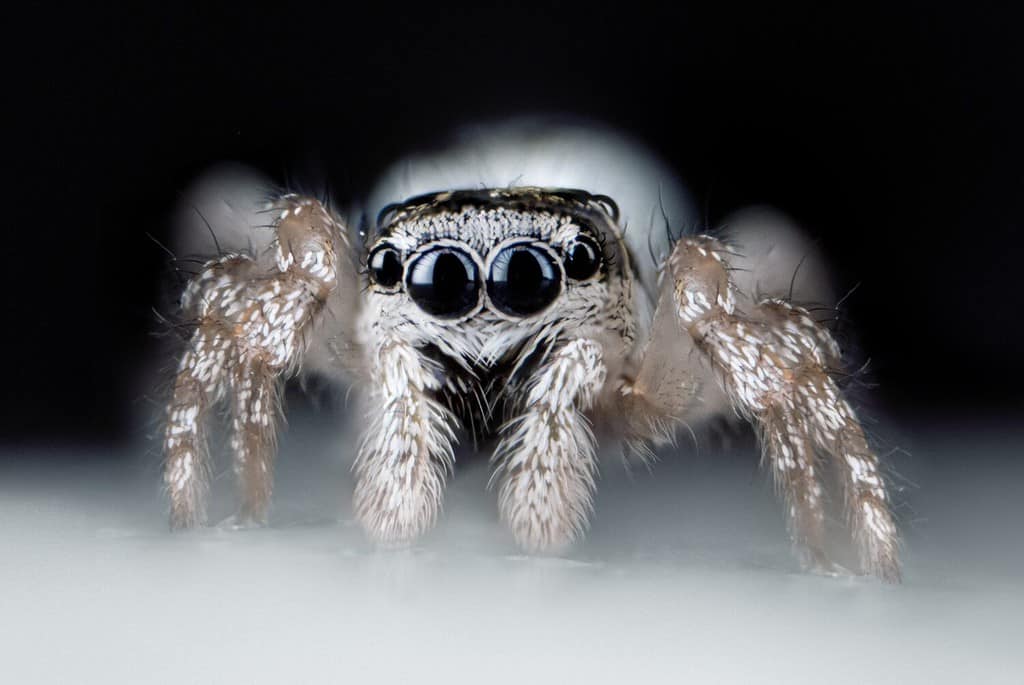
Spider reproduction is a fascinating and complex topic.
©Dmytro Khlystun/Shutterstock.com
Before diving into spider reproduction, let’s familiarize ourselves with some basics about these eight-legged creatures:
- Spiders are arachnids, not insects.
- They have eight legs, while insects have six.
- There are over 45,000 known species of spiders.
- Spiders are found on every continent except Antarctica.
- Many spiders are venomous, but only a few are harmful to humans.
- Spiders’ bodies have two parts – the cephalothorax and abdomen.
- They produce silk, which they use to spin webs, create egg sacs, and more.
- Some spiders live only for a year, while others can live up to 20 years.
- Most spiders are predators, mainly feeding on insects and other small creatures.
- The size of spiders varies greatly, from the tiny Samoan moss spider to the massive Goliath bird-eater.
Types of Spiders

Spiders use their silk for several purposes during reproduction, mating, and courting.
©SakSa/Shutterstock.com
Spiders are an incredibly diverse group of arachnids that inhabit various regions across the globe. Among the most well-known types of spiders are orb-weaver spiders, which can be found in numerous locations worldwide. These remarkable creatures construct intricate webs to ensnare their prey, showcasing their exceptional hunting strategies.
Another widespread spider species is the wolf spider, known for its agility and speed. Found in various corners of the world, these formidable predators do not rely on webs to catch their prey but instead actively hunt them down with impressive precision and quick reflexes.
Jumping spiders also deserve mention when discussing common spider types. These charismatic arachnids have a global presence and possess incredible jumping capabilities that rival those of some vertebrates. With acute vision and unique mating rituals involving elaborate dances, jumping spiders showcases both beauty and intelligence in their behaviors.
In North America, black widow spiders hold a notorious reputation due to their venomous bite. Recognized by their glossy black bodies adorned with distinctive red markings, they strike fear into many people’s hearts despite being relatively shy creatures that prefer hiding away from human interaction.
Venturing further into different parts of the world, we encounter tarantulas. An iconic group of large-bodied spiders inhabiting three continents: the Americas, Africa, and Asia. Fascinatingly diverse in appearance and behavior within this genus, tarantulas captivate enthusiasts worldwide with their stunning colors or intimidating size.
Lastly, huntsman spiders, scientifically known as Sparassidae, are a diverse group of arachnids that thrive primarily in warm temperate to tropical regions across multiple continents. With over 1,200 recognized species worldwide, they have successfully adapted to various habitats, including forests, grasslands, deserts, and even urban environments. These remarkable creatures boast an impressive range spanning from the African savannas to the lush rainforests of Southeast Asia and beyond.
Spider Reproduction— Mating Rituals
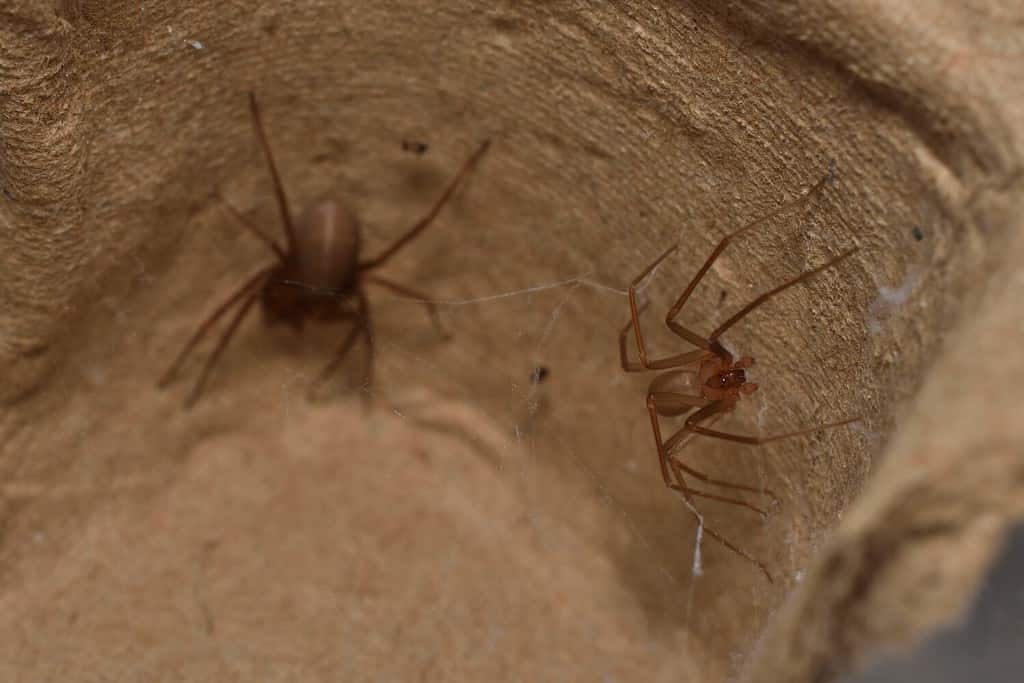
Spider mating and reproduction is often a quick affair.
©Tobias Hauke/Shutterstock.com
Mating rituals play a critical role in spider reproduction; they help male spiders convince females that they are suitable mates and not food! Depending on the species, males could perform complex dances, present gifts (usually food), or even pluck strands on the female’s web in a specific pattern.
Spider mating rituals are incredibly diverse and fascinating. One intriguing example is the mating ritual of the peacock spider, where the male showcases his brilliantly colored abdomen in a mesmerizing dance. This extravagant display not only captures the female’s attention but also serves as a form of communication, conveying information about his fitness and genetic quality.
In stark contrast to this flamboyant display, another species known as the gift-giving male nursery web spider has developed a unique strategy to impress potential mates. During courtship, these males meticulously wrap an insect in silk before presenting it to the female as a special offering or token of affection. This behavior might seem peculiar to us humans, but for these spiders, it plays a crucial role in securing successful reproduction.
By providing their prospective partners with wrapped gifts, these resourceful spiders demonstrate their ability to locate prey and showcase their hunting skills. The carefully selected insect acts as both sustenance for the female during copulation and an indicator of the male’s ability to provide adequate resources for future offspring.
These distinct examples highlight just how intricate and varied spider mating rituals can be within different species. From visually captivating dances aimed at dazzling females’ discerning eyes to thoughtful offerings intended to woo potential mates with valuable resources – each approach demonstrates nature’s remarkable adaptations when it comes to ensuring reproductive success among spiders.
Spider Mating

A Maratus tasmanicus, a peacock spider male, dances a mating dance to attract a female.
©iStock.com/crbellette
The actual mating process in spiders is quite unique. Male spiders don’t have typical reproductive organs. Instead, they produce sperm within their body that they then transfer to specialized appendages called pedipalps. During mating, the male inserts his pedipalp into the female’s genital opening (epigyne) to transfer his sperm.
However, this process can be dangerous for males, as some female spiders are known for their cannibalistic tendencies. To minimize this risk, males often choose young females who have just molted or resort to swift copulation followed by a hasty retreat.
Spider Reproduction

Many spiders protect their egg sacs with their lives to ensure the survival of their offspring.
©RealityImages/Shutterstock.com
The female spider’s reproductive system consists of two ovaries connected by tubes where fertilization occurs. After mating, the female stores the male’s sperm in a special chamber until she’s ready to lay eggs.
When laying eggs, she releases them into an egg sac made from her silk, where they get fertilized by the stored sperm. The number of eggs can vary drastically between species – from a few dozen to several thousand!
After some time (which varies between species), tiny spiderlings emerge from the eggs within the sac. They often stay inside until their first molt before venturing into the world.
Parental Care in Spiders
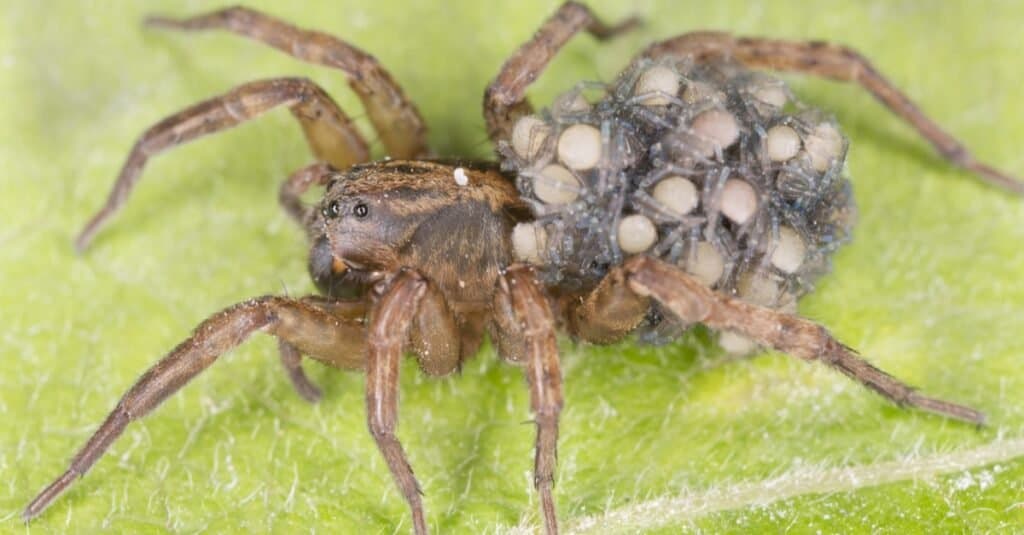
A female wolf-spider will carry her baby spiders on her back and feed the.
©Henrik Larsson/Shutterstock.com
Parental care is surprisingly common in spiders and plays a vital role in ensuring spiderlings’ survival. This care can range from simply guarding the egg sac to more involved behaviors like feeding and carrying spiderlings.
In wolf spiders, for instance, females carry their egg sacs attached to their spinnerets. Once hatched, spiderlings climb onto their mother’s back and stay there until they’re ready to fend for themselves.
Desert spiders (Stegodyphus lineatus) store food for their babies. First, she eats the food; then, she regurgitates it in tiny amounts for her tiny spiderettes. After the babies reach 2 weeks old, they then consume their mother’s body.
Interesting Facts about Spider Mating and Reproduction
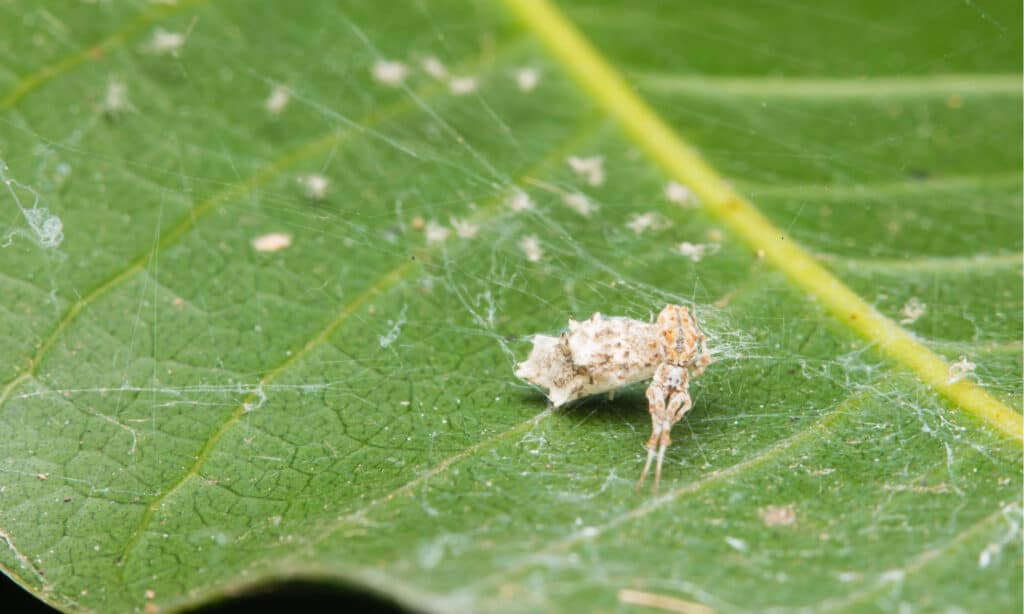
Feather-legged orb weaver spiders keep their egg sacs safe.
©Somyot Mali-ngam/Shutterstock.com
Here are some fascinating tidbits about spider mating and reproduction:
- Male redback spiders actually assist females in sexual cannibalism by flipping their bodies toward the females during mating!
- Some female spiders can store sperm for several years before using it to fertilize eggs.
- Certain female spiders produce a pheromone that prevents other males from courting them after successful copulation.
- Some spiderlings practice matriphagy – consuming their mother for nourishment!
Spiders in the Ecosystem
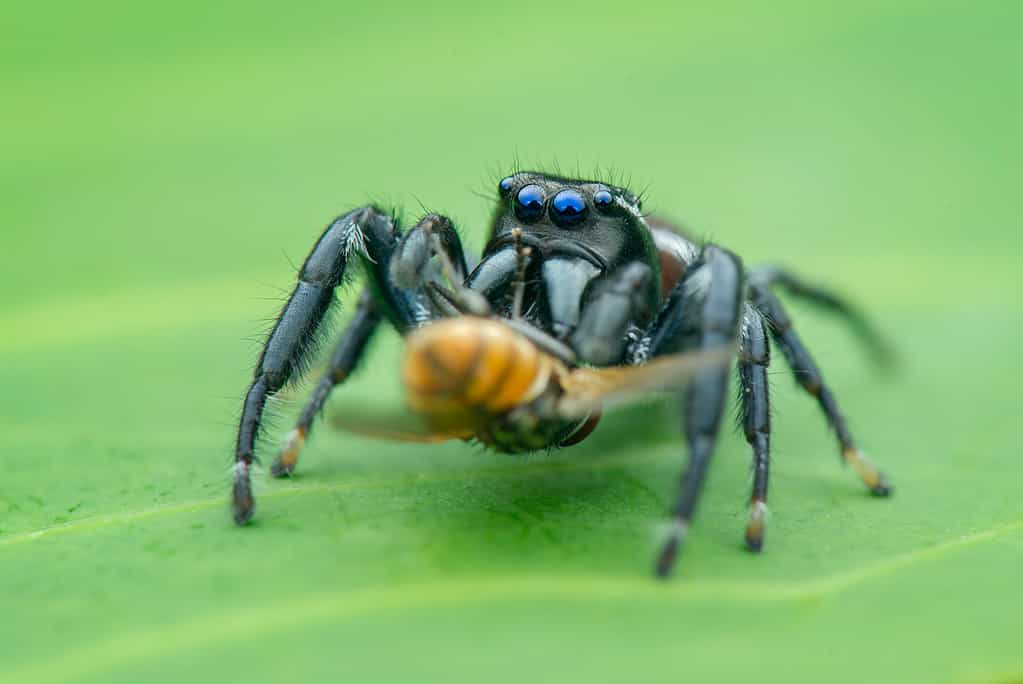
Paraphidippus aurantius, emerald jumping spiders, are excellent hunters.
©DWI YULIANTO/Shutterstock.com
Spiders are an essential part of the Earth’s ecosystems, playing a vital role in regulating pest populations, improving soil quality, and providing food for other animals. They have a wide range of habitats, ranging from deserts to forests, and can be found in almost every corner of the world.
Spiders are important predators, helping to keep insect populations in check. By reducing insect populations, spiders can help to reduce the spread of disease and reduce crop damage. They also improve soil quality by consuming organic matter, which can help to improve soil fertility and promote the growth of beneficial plants.
Spiders also provide a food source for many other animals. Birds, reptiles, and amphibians all consume spiders for sustenance. This helps to maintain a healthy balance of predators and prey, which is crucial to the health of ecosystems.
Overall, spiders are an important part of the Earth’s ecosystems, providing essential benefits to both humans and other animals. They play an integral role! By understanding the importance of spiders and conserving their habitats, we can help to ensure their continued presence in our world.
Conclusion
Spider mating and reproduction is an intricate and fascinating process filled with elaborate rituals, strategic maneuvers, and remarkable biological adaptations. Our exploration has only scratched the surface of this captivating subject. There’s always more to learn in the mesmerizing world of spiders! So keep exploring, keep learning, and most importantly – appreciate these incredible creatures for their unique contributions to our diverse ecosystem!
The photo featured at the top of this post is © Tushar Chindarkar/Shutterstock.com
Thank you for reading! Have some feedback for us? Contact the AZ Animals editorial team.







